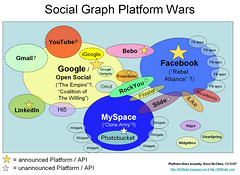I’ve recently put a lot of time into Zemanta stuff working in Opera. There are a few things I’ve noticed that really bother me as a developer when developing for Opera.
 Image via Wikipedia
Image via Wikipedia-
The easiest way to be sure you’re getting a non cached file is to actually have it open in a tab and reload that tab. Emptying the cache does not seems to work as I’ve found out while caught in an alert loop.[1]
-
I found the “don’t run scripts on this page anymore” checkbox in the alert box fascinating, but less so after I clicked it and couldn’t find a way to turn scripts back on for that specific page. Fortunately restarting the browser did the job.
-
We load a loader.js that in turn loads other Javascript and CSS files. Unfortunately it seems I have to manually load these files in tabs in order to get them to work – even though I can see them in Dragonfly when I click them they seem to be blank. When I reload, the content appears. After that they work as expected. But even then I don’t see them loaded in the Network tab of Dragonfly.
-
Can’t get the CSS loaded from a script to work. I don’t have any ideas, they just don’t work. I don’t see them in Dragonfly network tab (but I don’t see Javascript files either and they work).
-
When using Dragonfly I cannot get out of the inspect DOm mode so I can’t use the site to do something while watching what is happening in the DOM – what you must do is switch to a different tab, do your stuff and then switch back.
-
When you look at errors on a WordPress page Opera spits out loads of “-… is an unknown property” – thanks very much but properties that start with a – are supposed to be unknown to most of the browsers as they are vendor specific. This means that finding the error you’re looking for is much more difficult than it should be.
What I really hate the most when working with Opera is the lack of information about what is going on. They’ve added some really nice features in the recent releases but it is still quite far away from being a browser that people develop for. In this way it is sort of similar to IE but IE is a must and Opera isn’t…
If any of these are my mistakes I’d be glad if someone set me straight and taught me to use Opera as a developer. I bet others would too.
Related articles by Zemanta
- Opera 10 Beta Arrives (lockergnome.com)
- Faster, Sleeker Opera 10 Is Built for Better Web Apps (webmonkey.com)
- When you have a loop that alerts something and you keep getting the alert – the only way of getting out is removing the alert from code, emptying cache and trying to hit reload between alerts. In Opera this does not seem to work as the only way to get the new file is to reload the file and you can’t do that between alerts. back
![Reblog this post [with Zemanta]](http://img.zemanta.com/reblog_e.png?x-id=41c1fff0-584c-4e49-b175-7f9ec1d1cb9c)
![Reblog this post [with Zemanta]](http://img.zemanta.com/reblog_e.png?x-id=a8d576e4-f0a2-4415-8f0c-fccd712a530e)
![Reblog this post [with Zemanta]](http://img.zemanta.com/reblog_c.png?x-id=70c1647e-7fc8-46ae-a323-fa2f71eaf793)

![Reblog this post [with Zemanta]](http://img.zemanta.com/reblog_c.png?x-id=7dd9c6e4-9b7b-49e6-8d50-b12fef745867)